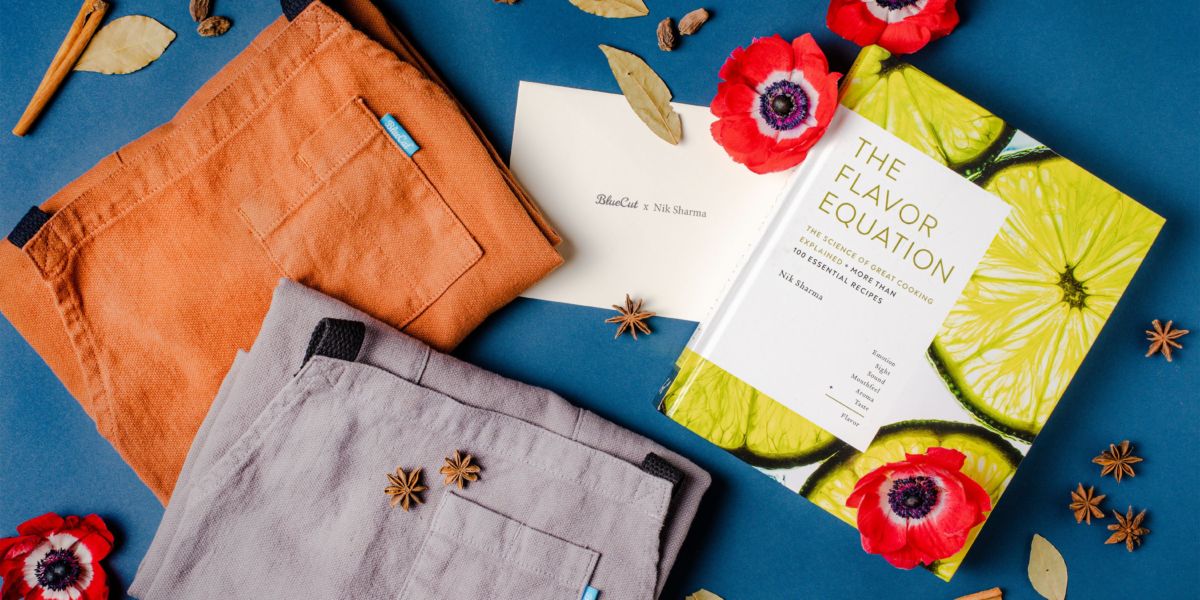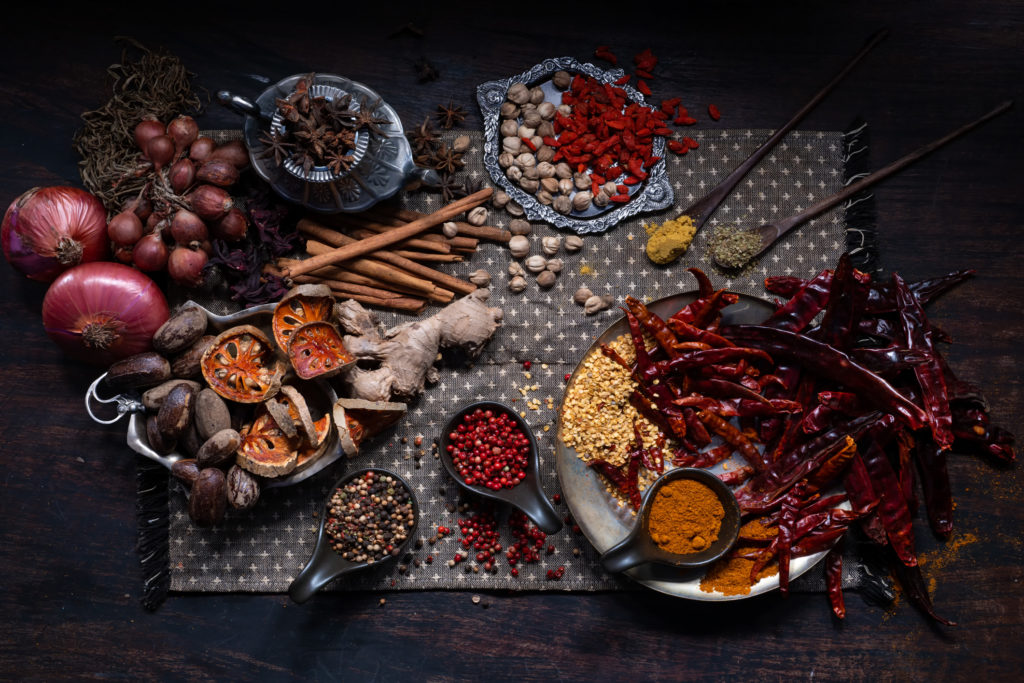
How to Stock Your Pantry So You Can Cook Authentic Indian-Inspired Food at Home
Try your hand at Indian-inspired cooking at home.

When it comes to exploring new styles of cooking at home, I sometimes feel like each recipe requires its own grocery trip with lists of ingredients that are at times foreign to not only me but also the shelves at my local grocer. Living in Southern California, we are lucky enough to have specialty stores across the city that carry unique goods and products from other countries and cultures. I frequent one of the many India Sweets and Spices stores for any Indian ingredients I need. (I can also find Bhan Kanom Thai for Thai curries, sweets, and unique produce.) Though when browsing the aisles, I often find myself grabbing items off of the shelf that spark my interest but I don’t actually know how or when to use them.
For instance, I grabbed a log of date paste last time I took a trip to India Sweets and Spices and had no idea what to do with it. After a couple of weeks of staring at it in my cabinet, I googled the sticky paste and found I could use it to sweeten curries or sauces. Now I add a tablespoon to my tomato sauces instead of sugar, and it balances the tartness from the tomatoes perfectly. As with most of the stories I tell, I will keep a potentially long story short by saying it’s important to branch out of your go-to grocery store on occasion, not only to try new ingredients but also to support small businesses doing their part to ensure different cultures and cuisines are represented with authentic ingredients straight from the source.
Last week, I spoke with Nik Sharma and he talked to me about his upbringing with Indian food and how moving to America later in life influenced the style of food he now makes and expertly writes about. He shared recipes for samosa pie, a delicious masala shrimp, and a couple more special dishes. In order to try his recipes and most Indian-inspired recipes authentically at home, you’ll need to get your hands on some spices, oil alternatives, and a few other ingredients you might not find at a Ralphs or Safeway.
This week, I chatted with Chachi Prasad, founder, and owner of BlueCut, a handcrafted apron and chef’s gear company based out of Los Angeles. He gave me some much-appreciated background on his childhood in Bihar, told me how it’s influenced his relationship with food today, and listed some essential items to keep in your kitchen as you explore Indian styles of cooking at home. Check out our full conversation below along with a shopping list for your next trip to the Indian grocer.

Katrina Frederick
Sunset: Where are you from, and how did your upbringing influence the food you crave, eat, and make today?
Chachi Prasad: I immigrated to the U.S. from India when I was around 6 years old. I have a deep connection and vivid memories with the food I ate in India. I can still smell my grandmother’s paratha, made from scratch, hitting the pan and slightly puffing up as she brushed it with extra ghee. Growing up in New York, we were exposed to some incredible cultures which offered our palettes a wide array of experiences. This includes French, Italian, Jamaican, Puerto Rican, Portuguese, Brazilian, Persian, and many more foods.
At home, we always had Indian food. On the weekends, my mother would have breakfast ready as soon as we awoke, which usually consisted of roti, sabji, and dal, with an egg on the side as our taste of America. On Sundays, my mother made khichdi, a healthy and wholesome dish consisting of rice and lentils. She would char dried chili peppers, fennel seeds, and other spices with ghee and pour it into the khichdi. She would also make what I call “Indian mashed potatoes” with smoked dry chilies, onions, and spices. Sometimes these potatoes were inserted into a paratha and grilled over a pan with ghee. As a child, I enjoyed spending time in the kitchen with my mother. My brothers were always with my father, learning how to fix cars, while I was learning how to cook. Today, I make it a point to prepare Indian food for my family. I want to make sure my daughter appreciates where her ancestry is from and the food that her dad grew up on.
For most basic American cooking, you might grab milk, butter, all-purpose flour, garlic, onions, cheese, etc. What are the staples of an Indian household’s pantry?
The “must-haves” in a pantry include ghee, turmeric, coriander, cumin, cinnamon, cardamom, nutmeg, clove, cumin seeds, saffron, basmati rice, moong dal, and dried chilis. Be sure to stock your fridge with ginger, onions, and fresh cilantro. It may seem like a lot but each spice contributes to a unique flavor profile and can be repurposed in a variety of other cuisines. Spices like turmeric are also packed with health benefits, as we all know!
What are the essential spices that might show up most often throughout the region of India you’re familiar with/from?
Turmeric, turmeric, turmeric! My dad is from the North and my mom is from the South, which meant I got the best of both regions when it comes to food. In my mom’s town, the most prevalent ingredients included tamarind, cinnamon, ginger, and curry leaves, mostly all cooked in coconut oil. In my dad’s region, dishes focused more on cardamom, ginger, turmeric, black pepper, chili, and bay leaves.
What are some dishes you might suggest someone diving into Indian cooking at home might start with and why? Are they the easiest, most delicious, most authentic?
Chicken curry or chicken tikka masala seem to be the most popular dishes to enjoy at home or try at a restaurant if it’s your first time exploring Indian cuisine. The key to many Indian dishes is patience. Many of the curry dishes require a slow cook over time, to capture the essence and flavors of the dish. Chicken curry is fairly easy and the most gratifying when it hits your plate and your palate.
What dishes do you find yourself cooking at home often?
I cook chicken curry and shrimp curry over basmati rice. My daughter and wife love these dishes. I also love papadum, which is a flash-fried large flat lentil chip. My childhood friends would say, “Let’s go to Chachi’s and ask his mom to make us the big potato chips.” It’s very similar but with a kick of spice. Of course, a vegetarian diet is limitless when it comes to Indian cuisine, I love aloo gobi with matar, (which is potatoes with a stew of cauliflower, potatoes, and green peas) and chana masala.
How do you feel Indian food is misunderstood or represented in the states?
Indian food is misrepresented in many ways. If you go to India, each region has its own specialty dishes. India has 22 official languages and over 700 dialects. Of course, each region’s cuisine is vastly different. When we would visit my mother’s town, I couldn’t wait to eat a crisp masala dosa and dip into warm sambar. When we would visit my dad’s town, it was all about the samosas, fresh roti, and tandoori. People in the U.S. think that Indian food has to have an overwhelming amount of spice for it to be authentic. The total opposite is true. Great Indian food has a balance of flavors and heat. I encourage those who are curious about Indian cuisine to explore restaurants with a regional specialty. Do a little research on an establishment, the chef, and the region of cuisine they focus on. It’s fascinating how many different types of Indian foods are available and it will provide a glimpse into how richly diverse the country is.
Basic Grocery List for Indian Home Cooking

Kittikorn Nimitpara
- Ghee
- Turmeric
- Coriander
- Cumin
- Cinnamon
- Cardamom
- Nutmeg
- Clove
- Cumin Seeds
- Saffron
- Basmati Rice
- Moong Dal
- Dried Chilis
- Fresh Ginger
- Onions
- Fresh Cilantro
- Tamarind Paste
- Curry Leaves
- Coconut Oil
